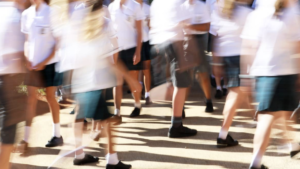Home » Commentary » Opinion » Towards a V-shaped educational recovery
· Canberra Times
 Now that all school students have returned to class, we must tackle the hard part, reversing the educational decline due to unnecessary and prolonged school closures.
Now that all school students have returned to class, we must tackle the hard part, reversing the educational decline due to unnecessary and prolonged school closures.
The education penalty borne by students is plain to see. For most, home-based learning – despite the best efforts of teachers, parents, and students – has resulted in less learning time, over-reliance on independent study, demands on parental supervision, and ineffective technology use. All of which harms disadvantaged students most.
Students disproportionately impacted are those outside the major cities, where digital readiness and capabilities of schools have lagged. There’s also the white elephant in the room of unequal connectivity and bandwidth capacity for households across regional Australia despite the expensive NBN. Together, this has compounded existing city-country educational divides.
Before even counting the costs from school closures, socioeconomically disadvantaged students are 35 weeks behind a typical student in maths by the age of 15. On top of that, CIS research shows that disadvantaged students in some states could have fallen a further (avoidable) three weeks behind in numeracy.
Recovering this lost learning is achievable but cannot be treated with complacency. A more coherent response will be needed from policymakers and schools.
Priorities must be identifying students’ learning gaps, assessing schools’ pandemic responsiveness, ensuring flexible school funding to address identified needs, and constructively leveraging technology.
Monitoring students’ progress while learning at home has been exceedingly difficult, meaning teachers and schools are essentially flying blind. It’s true they can use non-standardised “formative assessments” – judgments from informal classroom observations and interactions. But even at the best of times, those tools are prone to subjectively misdiagnosing students’ true educational needs.
Accountability has been put on hold with the scrapping of NAPLAN for this year. The premature abandonment of tests – originally scheduled for last month – means there’s no standardised, objective, and comparable measure of students’ learning in 2020.
A learning diagnostic is needed now more than ever to triage the educational damage; particularly since students’ progress will vary greatly from when teachers last tested them. A standardised test could provide teachers and schools an objective guide to where students are at and where to target remedial attention.
The pandemic presents a rare window to compare schools’ and teachers’ practices – and even if students’ learning has been hampered, there’s plenty educators can learn from the experience.
Part of the recovery effort must identify and stocktake the effectiveness of schools’ COVID-19 responses and how resources have been spent.
It hasn’t taken long for usual, predictable lobbying for more school funding to aid the post-COVID educational rescue; with unwarranted calls for smaller classes, more teachers’ aides, and overtime pay for teachers.
One proposal is for additional “catch-up funding” to right the course, particularly using taxpayer money for expensive policy interventions backed by little evidence. Moreover, presumably this would be charged to the federal purse – meaning taxpayers in South Australia, Western Australia and the Northern Territory (where schools were closed only momentarily) would foot the bill for all the other states and territories (whose schools were stubbornly closed for up to nine weeks despite the consistent expert medical advice that it was safe for schools to remain open).
In any case, existing funding is more than adequate for the task, with additional provisions already made to cover new COVID-related cleaning and hygiene expenses. Not to mention that monitoring and nurturing students’ progress in core literacy and numeracy should be business-as-usual for schools, not cause for a financial windfall.
What’s needed is not more money, but more flexibility. Schools are confronted with vastly different challenges – since each has enjoyed varied success with home-based learning efforts – and need the autonomy to address them as they see fit.
Those that target resources to support students most at risk will earn educational bang for those bucks.
Digital sloppiness has worsened the impact of COVID closures and will continue to handicap students if we don’t develop a more constructive approach to educational technology.
When digital education and face-to-face instruction are properly combined, students learn best and teachers’ work is more effective.
For this reason, technology must be part of the solution, not a scapegoat. It just needs to be used as intended: as a tool for students to practise applying concepts they know, rather than to acquire new knowledge. And as a supplement, rather than a substitute, for face-to-face teaching.
We’ve belatedly flattened the curve on lost learning with the return to school. A V-shaped education recovery is possible, but there’s no time to lose.
Towards a V-shaped educational recovery